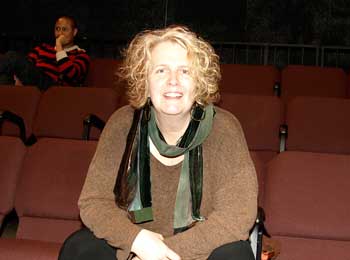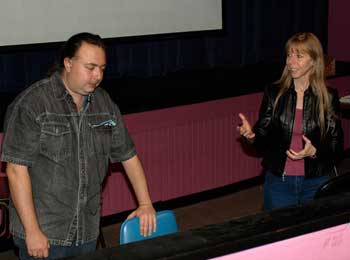A Conversation with
the Translators
Dramaturg Robyn Quick speaks with Juanita Rockwell and Yury Urnov about the translation of Playing Dead.
Juanita Rockwell has been a writer and director of projects at such theatres as Everyman, Theatre Project (Balto); The Ontological, Mabou Mines/Suite, Culture Project, (NYC); City Theatre (Pittsburgh); Teatro Municipão (São Paolo); RS9 (Budapest); and on NPR.
Produced writing includes The World is Round (opera), Waterwalk (site-specific), Cave in the Sky (multimedia/puppets), Lunar Pantoum (dance-theatre), and Between Trains (play with songs). Rockwell was founding director of Towson University’s MFA in Theatre where she still teaches, received Fulbright and Maryland Arts Council Playwriting Awards, and is a member of Dramatists Guild and the Stage Directors and Choreographers Society.
Yury Urnov was born in 1976 in Moscow, Russia. In 2000 he graduated from the Russian Academy of Theatre Arts with an MFA. Since then, he has worked in professional theatres all across Russia and in Moscow. He directed a number of premiers of plays that are part of the Russian New Drama movement. He has collaborated with playwrights Maksim Kurochkin, Olga Mukhina and Vladimir Sorokin. Urnov also directed and taught in Europe, Africa and the U.S.
RQ: What attracted you to this script? What about the script made you want to share it with an audience in the United States?
JR: I think this question is really for Yury, since I didn't have much input into the picking of the specific scripts. However, I would say the following:
In 2005, I was one of a group of American dramaturgs invited by Philip Arnoult and the Center for International Theatre Development to go to Yekaterinburg and see about 15 productions of new plays that he and John Freedman felt were part of a rebirth of playwriting in Russia. Directors had been the major creative forces in Russian theatre for decades, and I’d been seeing a similar focus on directing in Hungary, Poland, Slovakia, and other Eastern and Central European countries I’d visited. But something big seemed to be happening with this flood of playwriting that was coming on the scene in Russia, much of it in this isolated industrial city at the edge of Siberia. I was fascinated by the energy and changes happening in the world of playwriting there. I knew then that I wanted to be involved in a translation process, whether as director or writer, of one of the pieces in this exciting environment.
So I was thrilled that there was an opportunity for me to translate one of the plays that came out of this Yekaterinburg movement, by these two playwrights who had, in fact, been instrumental in creating the movement. I read the British translation of Playing the Victim and felt an aesthetic kinship with the flat dark humor of it: a certain skewed vision, a love of the elliptical, understated dialogue that can suddenly erupt into poetry.
YU: If we are talking about the most important names in this movement, the Presnyakov Brothers, as a team, would be among the top five. What is important for me in this wave is that people didn’t go in one direction. The playwrights we are presenting within this program mark five directions in the development of contemporary Russian drama. This play in particular was a big event in Russia. It was produced in the Moscow Art Theatre. The same director, Kirill Serebrennikov, also made a film version of the play with a screenplay by the Presnyakov Brothers. The film was presented on Channel One, the most widely-viewed television station in Russia.
RQ: Why do you think this script resonates so strongly with
contemporary Russians?
YU: Valya [the main character] is to some point presented as the Hamlet of a new generation in Russia. Russians view Hamlet as a national cultural character, and the play as the most important text for the Russian theatre. New theatrical interpretations resonate within the culture as important events. By evoking the myth of Hamlet in this play, the Presnyakovs created such an event in which this generation articulates itself. Valya can be considered a hero or a face of this generation.
RQ: The Presnyakov Brothers actually wrote TWO plays with this title. The previous version was translated and produced at the Royal Court Theatre in London. How is this play different from the previous version?
JR: It’s really a completely different play with quite a different sensibility. In the first play, there were none of the Hamlet references that serve as the central image and plot structure of this new play. And the endings of the two plays are almost polar opposites in both intent and effect. The first play didn’t have an inciting incident; we entered the play at a status quo and peered at a sad slice of our anti-hero’s life. This new play, like Hamlet, now begins with a dead father revealing that he was murdered by the man who now shares his widow’s bed, and off we go…
RQ: The title of the play was translated as Playing the Victim by Sasha Dugdale at the Royal Court. What led you to select the phrase Playing Dead instead?
JR: As for the title, I felt immediately that the American connotations of the idiomatic expression “Playing the Victim” were very different than how that title would be heard in England, where it had received the earlier translation. This question of the cultural ramifications of idiom is huge when you’re translating something: even if the basic denotation of the phrase is the same in two different countries, the connotation is how we experience language on a deeper level. I felt strongly that “Playing Dead” had a much more useful and appropriate connotation, especially for this new version of the play.
YU: I completely trust Juanita’s choice. I see many reasons for the word “victim” to have different weight and create different connotations in Russian and American minds.
RQ: The play makes a number of cultural references that are fairly specific to life in contemporary Russia. What were some of the moments that you found most challenging to translate for a U.S. audience and how did you attempt to address those challenges?
JR: Yury and I have talked a lot about the characters, and how the Presnyakovs are playing with Russian “types,” or caricatures. So how can these caricatures be recognized as such to an American audience? They somehow need to seem Russian to us, and yet they need to resonate with images we can understand as Americans.
There is a similar parallel in the Presnyakovs’ use of American pop culture references. People all over the world are familiar with South Park, and in some ways, this is a universally shared icon of ambivalence, irony and the ridiculous. So when the brothers put a South Park logo on Valya’s hat, on some level it means something very much the same as it does here. Similarly, young people are reading up on edgy sex tips in Marie Claire magazine whether they’re in Moscow or New York, but does it mean the same thing in both worlds? And housing multiple generations in one apartment may be more common here now in our present economy than it was a couple of decades ago, so perhaps we are increasingly similar.
But it’s important to acknowledge the cultural differences, as well. There has been no change in America as vast, as profound and as swift as the collapse of the Soviet Union, and somehow this translation needs to communicate that pall of history hanging over the world of the play. We’ll just have to keep threading that needle…
RQ: Can you describe a bit of your process? How did you work together as a team to create this script?
JR: I can only tell you how we have BEGUN to work, since we still have miles to go, but so far, our process has been significantly informed by the fact that we are both directors. I think we even share certain aesthetic interests and approaches, so there have been some wonderful conversations so far.
We started with Yury sitting across the desk from me in my office, translating the gist of the script as he flipped through the pages. I kept saying things like, “but what about that whole scene about the toilet?” and “so Valya has no opening monologue about crabsticks?” until I finally realized that this was a totally different play. Then Yury went back to Russia and wrote a literal, word-for-word translation of the script and emailed it to me.
Since then, we have had a couple of long conversations and a couple of long rehearsals that have enabled me to make significant changes and have also shown me how much more needs to be done to hear the tone of these characters’ voices and to find the flavor of this world.
RQ: How does this developmental reading at Towson University figure into your process? What do you hope to learn at this event? How do you imagine the script might change before it receives its first full production?
I am currently teaching a course on translation and adaptation in our MFA program here at Towson. The students in the class are doing 5 different projects, working from French, Spanish, Croatian, Sanskrit, and Middle English, so we are all working through the problems of translation together.
I completed a first draft in time to do a first informal table reading with the students in the translation class a few weeks ago, and Yury and Robyn were there to hear the reading and discuss what we heard. This is now a second draft you’re hearing tonight, and I will write another draft before we do our first read-thru with the cast at Single Carrot in December. Then I’ll have time for another major rewrite before we begin consistent rehearsals in January, and I’m sure I’ll be tweaking and rewriting as I come to rehearsals before we open in late February (check details at their website: HYPERLINK "http://www.singlecarrot.org"www.singlecarrot.org). So there’s a long way to go…
YU: One of the conditions of our project is that the plays are not considered finished until we have produced them. I think that’s a great possibility to examine the translation by theatrical means and I hope it will help to create a stageable text.

Translator Juanita Rockwell. Photo: Robyn Quick

Robyn Quick introduces Yury Urnov at a film presentation on Soviet comedy. Photo: Joe Castor



